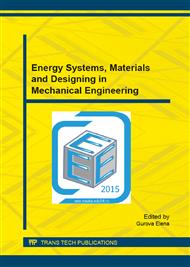[1]
Rizhkov A.V., Analysis and selection of rational structures of the cylindrical linear engine with magnetic stimulation, Voronezh, (2008).
Google Scholar
[2]
Hiterer M. Ya, Ovchinnikov I.E., Synchronous electrical machines reciprocating motion, Saint Petersburg, (2013).
Google Scholar
[3]
F. Cornelius, E. Horst, Development of a Free-Piston Linear Generator for use in an Extended-Range Electric Vehicle, in: EVS26 International Battery, Hybrid and Fuel Cell Electric Vehicle Symposium, 2012, pp.787-792.
Google Scholar
[4]
F. Lanzetta, P. Nika, Optimization of a dual free piston Stirling engine, in: Applied Thermal Engineering, 2007, pp.802-811.
DOI: 10.1016/j.applthermaleng.2006.10.021
Google Scholar
[5]
H. Polinder, F. Gardner, M. Damen, Design, modelling and test results of the AWS PM linear generator, in: Forschungsbericht, John Wiley and Sons LTD, Hoboken, (2005).
DOI: 10.1002/etep.56
Google Scholar
[6]
Sarapulov F.N., Sarapulov S.F., Shimchak P. Mathematical models of linear induction machines based on equivalent circuits, Krasnoyarsk, (2013).
Google Scholar
[7]
A.A. Kecaris, V.I. Duhanin, Questions workflow linear generator with a reciprocating, in: Proceedings of the 77th International Scientific and Technical Conference AAI MSTU MAMI, 2012, pp.36-42.
Google Scholar
[8]
P. Bryan, High Force Density Linear Permanent Magnet Engines, in: Electromagnetic Muscle Actuators, Massachusetts Institute of Technology, (2012).
Google Scholar
[9]
N.P. Gargov, A.F. Zobaa, Separated magnet yoke for permanent magnet linear generator for marine wave energy converters, in: Electric Power Systems Research, pp.63-70.
DOI: 10.1016/j.epsr.2013.11.021
Google Scholar
[10]
F. Rinderknecht, The linear generator as integral component of an energy converter for electric vehicles, in: European All-Wheel Drive Congress Graz, 2011. 7 р.
Google Scholar
[11]
J. Ribeiro, I. Martins, Development of a Low Speed Linear Generator for use in a Wave Energy Converter, in: International Conference on Renewable Energies and Power Quality Granada, 2010. 7 р.
DOI: 10.24084/repqj08.301
Google Scholar
[12]
V.E. Visotsky, Linear permanent magnet generator for power supply systems of autonomous objects, Proceedings of the universities. Electromechanics, 2010, pp.80-82.
Google Scholar
[13]
C.A. Oprea, C.S. Martis, F.N. Jurca, D. Fodorean, L. Szabу, Renewable Energy Applications: Tubular vs. Four-Sided Structures, in: Technical University of Cluj-Napoca, Europass CV, 2011, рp. 588-592.
DOI: 10.1109/iccep.2011.6036316
Google Scholar
[14]
S. Jang, Thrust Analysis and measurements of tubular linear actuator with cylindrical halbach- array, in: IEEE Transactions on magnetics, (2005).
DOI: 10.1109/tmag.2005.846266
Google Scholar
[15]
Sergeenkova E.V. Synchronous electrical machine reciprocation (generator), Moscow, (2011).
Google Scholar
[16]
J. Xiao, L. Qingfeng, Z. Huang, Motion characteristic of a free piston linear engine, in: Applied Energy, 2010, pp.1288-1294.
DOI: 10.1016/j.apenergy.2009.07.005
Google Scholar
[17]
Y. Song, H. Feng, Z. Zuo, M. Wang, C. Guo, Comparison Research on Different Injection Control Strategy of CI Free Piston Linear Generator in One-time Starting Process, in: Energy Procedia, 2014, pp.1597-1601.
DOI: 10.1016/j.egypro.2014.12.180
Google Scholar
[18]
H. Karabulut, Dynamic analysis of a free piston Stirling engine working with closed and open thermodynamic cycles, in: Renewable Energy, 2011, pp.1704-1709.
DOI: 10.1016/j.renene.2010.12.006
Google Scholar
[19]
X. Shuaiqing, W. Yang, Z. Tao, X. Tao, T. Chengjun, Numerical analysis of two-stroke free piston engine operating on HCCI combustion, in: Applied Energy, 2011, pp.3712-3725.
DOI: 10.1016/j.apenergy.2011.05.002
Google Scholar
[20]
A.G. Santana, D. Andrade, A. Villa Jaen, Output Power of Linear Generator under Reactive Control in Regular Waves, in: ICREPQ, 2011, 6 р.
Google Scholar


